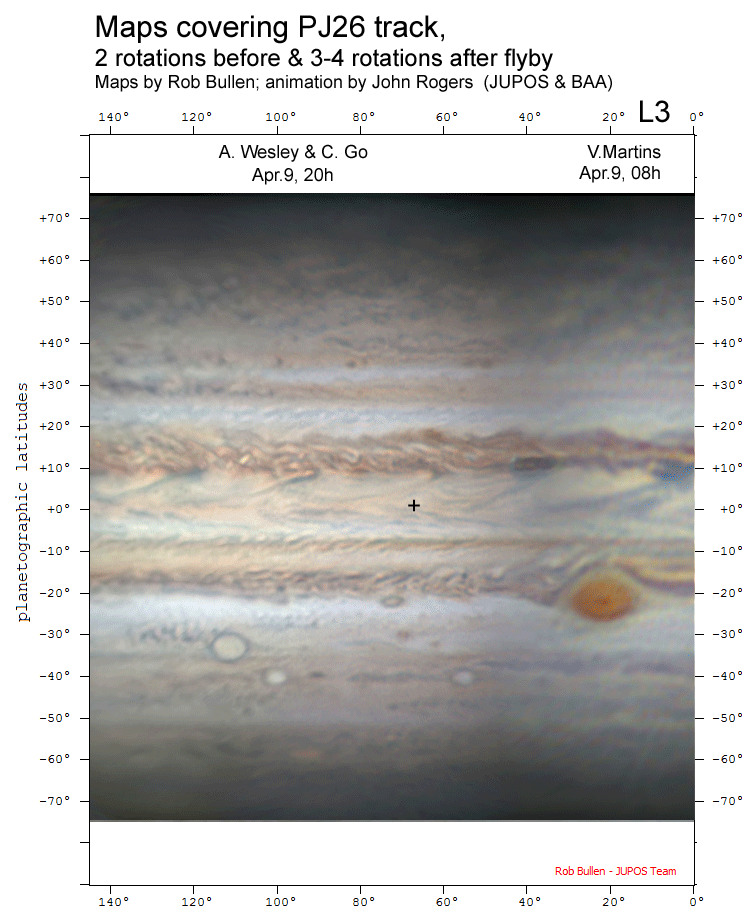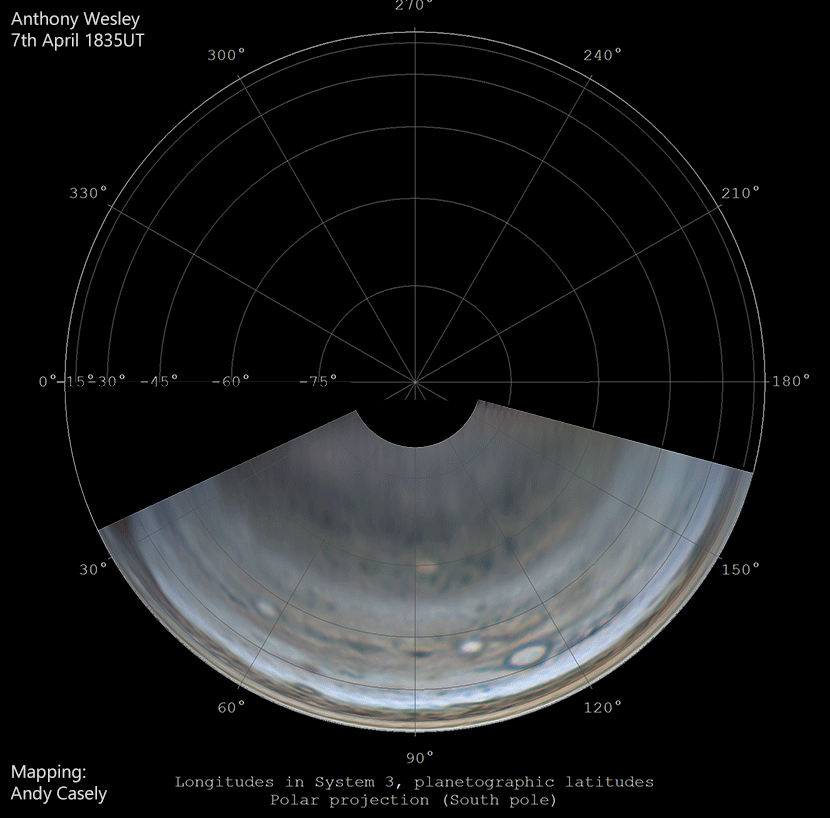Jupiter in 2020, Report no.3: Context for PJ26, & a new NEB expansion event
This report on ground-based images has three aims:
–to present maps and images produced by amateur observers around the time of Juno’s Perijove-26 (PJ26) on 2020 April 10, giving context to the JunoCam images described in our report on PJ26;
–to draw attention to a probable new NEB Expansion Event that appears to have developed in the last two months, but was not identified until now;
–to briefly summarise the present state of the major atmospheric features.
___________________________________
The report, including miniature figures, is here as a PDF: Report-2020-no-3_PJ26&NEB.pdf
(The whole text is also posted below.)
The full-size figures are here in a ZIP file: Jup-Report-2020-no-3_Figures.zip
The ZIP file includes two animations of maps, which are also posted below.
Animation-1, is a blink of two cylindrical maps of ground-based images made by Rob Bullen, covering the PJ26 track, 6 rotations apart. The cross marks the point where Juno crossed the equator.
Animation-2, by Andy Casely, shows the evolution of the south polar region from April 7-14 in five south polar projection maps including the JunoCam map.


___________________________________
A probable new NEB Expansion Event:
The NEBn edge has been conspicuously irregular throughout the apparition, but no pattern was noticed in it until Chris Go suggested on May 1 that an ‘outbreak’ might be occurring. A full account of the situation is deferred to our next report, but it can be summarised as follows, based largely on maps produced by Shinji Mizumoto, Rob Bullen, and Joaquin Camarena.
Some large sectors of the NEBn in Feb. and March showed prominent undulations with wavelengths of ~12º-21º. Alignments of maps shows that these were drifting with DL3 ~ +14 deg/30d (DL2 = +6 deg/30d) in Feb. and DL3 ~ +19 deg/30d (DL2 = +11 deg/30d) in March. These retrograding speeds, esp. the latter, are unusual, indicating that the waves were influenced by the NEBs retrograding jet. They were only observed before the rifted sector passed by. Unlike the waves seen during and after the expansion event in 2017, these waves were not apparent in methane images.
A new rifted region started with a white spot that was in mid-NEB just Sf. White Spot Z from Feb.5 and brightened on Feb.17, at ~14ºN (C. Foster). By Feb.22 it was developing into a complex rift system Sp. WSZ, which was never very bright, but prograded and expanded into a large, very turbulent sector throughout March. In late March, some sectors of NEB p. WSZ were inflated northward to 20ºN with this turbulence, and these have now stabilised as expanded sectors of NEB while new ones are appearing further p. – separated by white patches. Figure 3 is the latest map. So this appears to be a NEB Expansion Event that has been promoted by this rifted region from March onwards.
At non-rifted longitudes, throughout the apparition, there is a prominent red-brown NEB component (now a NEB(S)). Remarkably, it is bright in methane images, indicating high altitude for the red colour (Figs.4 & 5A). (This is not so obvious in images taken of the PJ26 track and the GRS hemisphere because these were affected by the rift system: Figs.4, 5B, 7, 8.)
Summary of other recent changes
We gave a description of the planet up to early March in our 2020 Report no.1, and a thorough account of the S. Temperate domain up to early April in 2020 Report no.2. Since then:
NNTZ: NN-LRS-1 is now conspicuously red.
EZ: There is still significant pale ochre colour in the EZ, esp. the central part which is also very methane-bright (Figs.4 & 5). The southern strip is white but methane-dark.
SEB: The SEB is mostly very quiet, but the post-GRS convective activity continues at a low level, and there are some rings retrograding on the SEBs jet.
GRS: Several observers have been keenly monitoring the GRS following last year’s ‘red flaking’ events. A series of SEBs rings had entered the Red Spot Hollow in Feb., but none for 6 weeks after March 9, and only minor disturbances occurred around the GRS during that time. However, another series of rings has now arrived, starting with one entering the Hollow on April 24. A red, methane-bright flake duly appeared at the f. end of the GRS on April 30 (C. Foster). It disappeared within a few days, but we await further developments.
STB: The important phenomena in the S. Temperate domain have been described in our 2020 report no.2 and our report on PJ26, so will not be covered here. Figures 2, 3, 7 & 8 show the region of interest. The PJ26 closeup images covered most it, and the remainder (near the GRS) should be imaged at PJ27. The STB dark spot (p. oval BA) has become a well-defined feature, and the ‘streak’ (passing the GRS) increasingly appears to have small white spot embedded in it, so both are still candidates for a future cyclonic sector.
Maps and images covering PJ26
Several observers produced excellent images around the time of PJ26, and several recorders produced maps based on them. A selection of these are shown in the following figures and animations, all including the region of the PJ26 track except Fig.5. Details are explained in our posted report on PJ26. Credits are on the figures. Maps are in L3 with north up, unless otherwise stated.
Figure 1: North polar projection map of the northern hemisphere, April 10-11.
Figure 2: Cylindrical map of the whole planet, April 10-12, annotated.
(Also see Animation-1, which blinks two maps covering the PJ26 track.)
Figure 3: Cylindrical map of the whole planet, April 27-28, showing changes since Fig.2, particularly in the NEB.
Figure 4: Two sets of cylindrical maps of the planet, April 9-12, in visible colour (RGB), near-IR (I-band), and methane (CH4).
Figure 5A: Paired RGB and CH4 images, demonstrating the mismatch between them in the NEB and EZ, where the red NEB component is methane-bright (not including the rifted sector).
Figure 5B: Set of images in RGB, IR, CH4, and UV, within the rifted sector.
Figure 6: Three maps aligned in L1, from March 29 to April 12, covering the PJ26 track, which happened to be close to the p. end of the rift system. NEBs dark projections are at approx. constant L1. Two of them, on the p. (right-hand) side, are very large and dark, but one under Juno’s track (at L1 = 17) shrinks as the rift system passes. A cross marks where Juno crossed the equator.
Figure 7: Two pairs of v-hi-res images in RGB and CH4, covering Juno’s track one rotation before and five rotations after PJ26. Features in the S. Temperate domain, and some other anticyclonic ovals, are annotated.
Figure 8: A more extensive series of RGB & CH4 images covering the S. Temperate domain from March 30 to April 26.
Figure 9: South polar projection maps, April 12 & 14.
(Also see Animation-2, an animation by Andy Casely of four such ground-based maps with the JunoCam map.)
| The British Astronomical Association supports amateur astronomers around the UK and the rest of the world. Find out more about the BAA or join us. |
